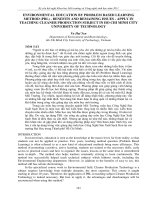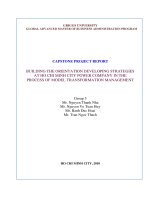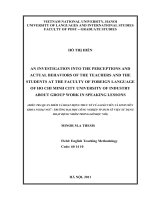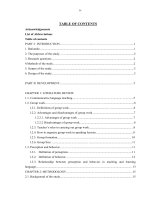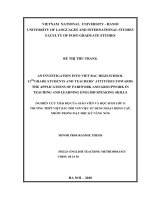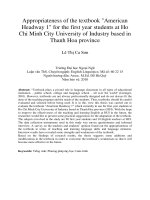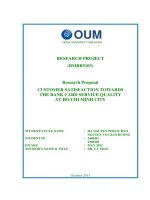students’ and teachers’ attitudes towards the international training and education center’s english curriculum at ho chi minh city university of science
Bạn đang xem bản rút gọn của tài liệu. Xem và tải ngay bản đầy đủ của tài liệu tại đây (1.17 MB, 155 trang )
MINISTRY OF EDUCATION AND TRAINING
HO CHI MINH CITY OPEN UNIVERSITY
VƯƠNG PHẠM THÙY VÂN
STUDENTS’ AND TEACHERS’ ATTITUDES TOWARDS THE
INTERNATIONAL TRAINING AND EDUCATION CENTER’S
ENGLISH CURRICULUM AT HO CHI MINH CITY
UNIVERSITY OF SCIENCE
MASTER OF ARTS IN TESOL
Ho Chi Minh City, 2019
MINISTRY OF EDUCATION AND TRAINING
HO CHI MINH CITY OPEN UNIVERSITY
VƯƠNG PHẠM THÙY VÂN
STUDENTS’ AND TEACHERS’ ATTITUDES TOWARDS THE
INTERNATIONAL TRAINING AND EDUCATION CENTER’S
ENGLISH CURRICULUM AT HO CHI MINH CITY
UNIVERSITY OF SCIENCE
Major: Teaching English to speakers of other language
Major code: 60140111
MASTER OF ARTS IN TESOL
Supervisor: NGUYỄN HOÀNG TUẤN, PhD
Ho Chi Minh City, 2019
i
STATEMENT OF AUTHORSHIP
I certify that this thesis entitled “Students‟ and Teachers‟ attitudes towards the
International Tranning and Education Center‟s English Curriculum at Ho Chi Minh
City University of Science” is my own work.
Except where reference is made in the text of the thesis, this thesis does not contain
material published elsewhere or extracted in whole or in part from a thesis by which
I have qualified for or been awarded another degree or diploma.
No other person‟s work has been used without due acknowledgement in the main
text of the thesis.
This thesis has not been submitted for the award of any degree or diploma in any
other tertiary institution.
Ho Chi Minh City, September 2019
VUONG PHAM THUY VAN, MRS.
ii
ACKNOWLEDGEMENTS
First of all, I am deeply indebted to my supervisor, Dr. Nguyen Hoang Tuan, whose
compassion, encouragement and guidance throughout the research have helped in
the completion of this thesis. I am truly appreciated his comments, enthusiasm;
kindness and calm to instruct me during a long time of doing this research.
I am also sincerely grateful to all lecturers of the Open University in Ho Chi Minh
City for providing me with invaluable sources of intellectual knowledge during my
study there. The knowledge and experience I have learned from here is a valuable
present for me to improve my teaching career.
Besides, I would like to say thank you to all of the lecturers, staff, and students at
the ITEC- The International Training and Education Center of the University of
Science who have always supported me and help me to collect the most accurate
data to complete this thesis.
Last but not least, I would like to express my gratefulness to family and friends who
have never given up the trust in me and facilitate my research unconditionally;
especially my deceased Mom who encouraged me to pursue higher education after
the Bachelor‟s degree.
iii
ABSTRACT
With the holistic purpose of improving the language teaching and learning
quality at the ITEC center of University of Science (Ho Chi Minh City), the study
focused on the students‟ and teachers‟ attitudes towards the current ITEC English
curriculum. The survey study was conducted at the ITEC center of University of
Science (Ho Chi Minh City) with the participation of 105 students and 15 teachers.
The instruments included the attitude questionnaires and the semi-structured
interviews. The quantitative data obtained from the questionnaires were analyzed by
SPSS version 20.0, while the qualitative data obtained from the interviews were
thematically analyzed. The findings show that both the students and the teachers
concurrently showed their positive affective, cognitive and behavioral attitudes
towards the clear objectives, assessment modes, teaching materials, and extra tasks.
In addition, content of the ITEC English curriculum were emotionally, cognitively
and behaviorally approved by both the teachers and the students; however, some
students thought that the content lacked an emphasis of culture elements and
updated realistic situations. Furthermore, while the teachers seemed to prefer the
time allotment of the courses of the curriculum, many students did not express their
favor or approval. Besides, a big proportion of the target students liked its teaching
methods and reckoned them as encouragement of their attendance and participation
of the given courses; by reason, they believed in the usefulness of the teaching
methods and delivery techniques, especially in developing and sharpening their
language skills and test-taking skills. Nevertheless, some of the teachers did not feel
these teaching methods impressive and they were not in line with their preferential
styles. Finally, considering the curriculum type of the ITEC English curriculum,
many teachers thought that the target curriculum belonged to the process-based one.
Based on the research findings, the paper concluded with some pedagogical
implications and a recommendation for further study in line of research on teachers
and students‟ attitudes towards the language curriculum.
i
TABLE OF CONTENT
STATEMENT OF AUTHORSHIP ......................................................................... i
ACKNOWLEDGEMENTS ..................................................................................... ii
ABSTRACT ............................................................................................................. iii
TABLE OF CONTENT ............................................................................................ i
LIST OF FIGURES AND CHARTS ..................................................................... vi
LIST OF TABLES ................................................................................................. vii
CHAPTER 1: INTRODUCTION ...........................................................................1
1.1. Introduction of Chapter 1 ..................................................................................1
1.2.
Rationale of the Study .......................................................................................1
1.3.
Research Aims ..................................................................................................3
1.4.
Research Questions ...........................................................................................3
1.5.
Significance of the Study ..................................................................................3
1.6.
Thesis Organization ..........................................................................................4
CHAPTER 2: REVIEW OF LITERATURE ........................................................5
2.1. Introduction of Chapter 2 ..................................................................................5
2.2.
Notion of Curriculum ........................................................................................5
2.3.
Types of Curriculum .........................................................................................7
2.3.1.
A Product-Based Curriculum .....................................................................7
2.3.2.
A Process-Based Curriculum .....................................................................7
2.3.3.
Learner-Centered Curriculum ....................................................................8
2.4.
Definitions and Roles of Attitudes in Language Acquisition ...........................8
2.4.1.
Definitions of Attitudes ..............................................................................8
2.4.2.
Roles of Attitudes in Language Acquisition ............................................10
2.5.
Conglomerates of Attitudes ............................................................................11
2.5.1.
Affective Conglomerate of Attitudes .......................................................11
2.5.2.
Cognitive Conglomerate of Attitudes ......................................................11
2.5.3.
Behavioral Conglomerate of Attitudes.....................................................12
ii
2.6.
Previous Studies ..............................................................................................12
2.7.
Research Gaps .................................................................................................15
2.8.
Conceptual Framework ...................................................................................17
2.9.
Summary of Chapter 2 ....................................................................................18
CHAPTER 3: METHODOLOGY ........................................................................19
3.1. Introduction of Chapter 3 ................................................................................19
3.2.
Research Setting ..............................................................................................19
3.2.1.
Location ....................................................................................................19
3.2.2.
ITEC English Curriculum ........................................................................20
3.3.
Research Participants ......................................................................................26
3.3.1.
Students ....................................................................................................26
3.3.2.
Teachers ...................................................................................................27
3.4.
Methods of Investigation ................................................................................28
3.4.1.
Overall Approach .....................................................................................28
3.4.2.
Research Instruments ...............................................................................29
3.4.2.1.
3.4.2.2.
3.5.
Questionnaires for Students and Teachers ................................................. 30
Semi-structured Interviews for Students and Teachers .............................. 34
Data Analytical Framework ............................................................................36
3.5.1.
Quantitative Analysis for Questionnaires ................................................36
3.5.2.
Qualitative Analysis for Interviews .........................................................36
3.6.
Reliability and Validity ...................................................................................37
3.6.1.
Definition .................................................................................................38
3.6.2.
Reliability of Research Instruments .........................................................38
3.6.3.
Validity of Research Instruments .............................................................39
3.7.
Pilot Study .......................................................................................................40
3.7.1.
Rationale for Pilot Study ..........................................................................40
3.7.2.
Pilot Results of the Questionnaires ..........................................................40
3.7.3.
Pilot Results of the Semi-structured Interviews .......................................42
3.8.
Summary of Chapter 3 ....................................................................................42
iii
CHAPTER 4: FINDINGS AND DISCUSSION ..................................................44
4.1. Introduction of Chapter 4 ................................................................................44
4.2.
Research Question 1 .......................................................................................44
4.2.1.
The Students‟ Attitudes towards the Objectives of the ITEC English
Curriculum .............................................................................................................44
4.2.2.
The Students‟ Attitudes towards the Content of the ITEC English
Curriculum .............................................................................................................47
4.2.3.
The Students‟ Attitudes towards the Time Allotment of the ITEC English
Curriculum .............................................................................................................51
4.2.4.
The Students‟ Attitudes towards the Teaching Methods of the ITEC
English Curriculum ................................................................................................54
4.2.5.
The Students‟ Attitudes towards the Assessment of the ITEC English
Curriculum .............................................................................................................57
4.2.6.
The Students‟ Attitudes towards the Teaching Materials of the ITEC
English Curriculum ................................................................................................60
4.2.7.
The Students‟ Attitudes towards the Extra Tasks of the ITEC English
Curriculum .............................................................................................................63
4.2.8.
4.3.
Discussion of Research Question 1 ..........................................................65
Research Question 2 .......................................................................................72
4.3.1.
The Teachers‟ Attitudes towards the Objectives of the ITEC English
Curriculum .............................................................................................................72
4.3.2.
The Teachers‟ Attitudes towards the Content of the ITEC English
Curriculum .............................................................................................................74
4.3.3.
The Teachers‟ Attitudes towards the Time Allotment of the ITEC English
Curriculum .............................................................................................................77
4.3.4.
The Teachers‟ Attitudes towards the Teaching Methods of the ITEC
English Curriculum ................................................................................................79
4.3.5.
The Teachers‟ Attitudes towards the Assessment of the ITEC English
Curriculum .............................................................................................................83
iv
4.3.6.
The Teachers‟ Attitudes towards the Teaching Materials of the ITEC
English Curriculum ................................................................................................86
4.3.7.
The Teachers‟ Attitudes towards the Extra Tasks of the ITEC English
Curriculum .............................................................................................................89
4.3.8.
The Teachers‟ General Attitudes towards the ITEC English Curriculum
Type
92
4.3.9.
Discussion of Research Question 2 ..........................................................93
4.4.
Summary of Chapter 4 ..................................................................................100
CHAPTER 5: CONCLUSIONS AND IMPLICATIONS .................................101
5.1. Conclusions ...................................................................................................101
5.2.
Implications ...................................................................................................104
5.3.
Limitations ....................................................................................................105
5.4.
Recommendations for Further Study ............................................................105
5.5.
Summary of Chapter 5 ..................................................................................106
REFERENCES ......................................................................................................107
APPENDICES .......................................................................................................113
APPENDIX A.1: QUESTIONNAIRE FOR STUDENTS .....................................114
(ENGLISH VERSION) ...........................................................................................114
APPENDIX A.2: QUESTIONNAIRE FOR STUDENTS (VIETNAMESE
VERSION) ..............................................................................................................117
APPENDIX B.1: QUESTIONNAIRE FOR TEACHERS .....................................120
(ENGLISH VERSION) ...........................................................................................120
APPENDIX B.2: QUESTIONNAIRE FOR TEACHERS (VIETNAMESE
VERSION) ..............................................................................................................124
APPENDIX C.1: SEMI-STRUCTURED INTERVIEW ........................................128
FOR STUDENTS (ENGLISH VERSION) ............................................................128
APPENDIX C.2: SEMI-STRUCTURED INTERVIEW FOR STUDENTS
(VIETNAMESE VERSION) ..................................................................................130
v
APPENDIX D.1: SEMI-STRUCTURED INTERVIEW FOR TEACHERS
(ENGLISH VERSION) ...........................................................................................132
APPENDIX D.2: SEMI-STRUCTURED INTERVIEW FOR TEACHERS
(VIETNAMESE VERSION) ..................................................................................134
APPENDIX E.1: A SAMPLED STUDENT TRANSCRIPT .................................136
APPENDIX E.2: A SAMPLED TEACHER TRANSCRIPT .................................140
vi
LIST OF FIGURES AND CHARTS
Figure 2. 1 Conceptual Framework of the Study ......................................................17
Figure 3. 1 Overall Approach of the Study ..............................................................29
Chart 3. 1 Description of Students‟ Profile ...............................................................26
Chart 3. 2 Description of Teachers‟ Profile ..............................................................28
Chart 4. 1 Teachers‟ General Attitudes towards the ITEC English Curriculum Type
...................................................................................................................................92
vii
LIST OF TABLES
Table 3. 1 The ITEC English Curriculum .................................................................21
Table 3. 2 The Link between the Research Questions and the Research Instruments
...................................................................................................................................30
Table 3. 3 The Description of the Student and Teacher Questionnaires ..................31
Table 3. 4 Reliability Index of the Student Questionnaire ........................................39
Table 3. 5 Reliability Index of the Teacher Questionnaire .......................................39
Table 4. 1 The Students‟ Attitudes towards the Objectives of the ITEC English
Curriculum ................................................................................................................45
Table 4. 2 The Students‟ Attitudes towards the Content of the ITEC English
Curriculum ................................................................................................................48
Table 4. 3 The Students‟ Attitudes towards the Time Allotment of the ITEC English
Curriculum ................................................................................................................51
Table 4. 4 The Students‟ Attitudes towards the Teaching Methods of the ITEC
English Curriculum ...................................................................................................55
Table 4. 5 The Students‟ Attitudes towards the Assessment of the ITEC English
Curriculum ................................................................................................................58
Table 4. 6 The Students‟ Attitudes towards the Teaching Materials of the ITEC
English Curriculum ...................................................................................................61
Table 4. 7 The Students‟ Attitudes towards the Extra Tasks of the ITEC English
Curriculum ................................................................................................................63
Table 4. 8 The Teachers‟ Attitudes towards the Objectives of the ITEC English
Curriculum ................................................................................................................72
Table 4. 9 The Teachers‟ Attitudes towards the Content of the ITEC English
Curriculum ................................................................................................................75
viii
Table 4. 10 The Teachers‟ Attitudes towards the Time of the ITEC English
Curriculum ................................................................................................................78
Table 4. 11 The Teachers‟ Attitudes towards the Teaching Methods of the ITEC
English Curriculum ...................................................................................................80
Table 4. 12 The Teachers‟ Attitudes towards the Assessment of the ITEC English
Curriculum ................................................................................................................84
Table 4. 13 The Teachers‟ Attitudes towards the Teaching Materials of the ITEC
English Curriculum ...................................................................................................86
Table 4. 14 The Teachers‟ Attitudes towards the Extra Tasks of the ITEC English
Curriculum ................................................................................................................89
1
CHAPTER 1:
INTRODUCTION
1.1. Introduction of Chapter 1
This chapter first provides a background of the study including a brief
introduction of the study, including the rationale of the study, research objectives,
research questions, and significance of the research project are presented.
1.2. Rationale of the Study
English now is no longer a property of native English speakers but it is also
used broadly by non-native speakers as a foreign language (Padwick, 2018). It
becomes a commonly used language for various fields such as technology, science,
commerce, administration, etc. In Vietnam, English becomes a compulsory subject
in most educational settings at different levels from primary to tertiary systems.
More specifically, most universities and colleges set English as a compulsory credit
course and students need to submit an international English proficiency test such as
TOEFL, TOEIC, IELTS as a graduation requirement. Being aware of the paramount
significance of English to the world development, many parents expect to send their
children to study abroad or study international programs at the tertiary level to seek
for a foreign degree which is considered to provide their children with better
opportunities for their career path and higher education.
Regarding social needs, international joint programs have steadily increased
and become a favorable choice for students who wish to achieve an international
bachelor's degree without living apart from their families. Not only is a requirement
for entrance, but English is also a compulsory requirement for tertiary graduation.
The International Training and Education Center (ITEC), which belongs to the
University of Science, is included; in specific, students following the ITEC English
curriculum need to submit the IELTS 6.0 or equivalent to earn a bachelor's degree
of the international joint program.
The ITEC English curriculum is established to test and train students‟ English
abilities to ensure that they can afford their academic programs which are taught
2
totally in English. This curriculum is expected to help them get the target IELTS
certificate before graduation. As a result, taking up English courses at the ITEC is
the obliged demand when the students choose to study their bachelor's degrees here.
The English program and the academic programs are run at the same time, and
students need to study both programs simultaneously until they achieve the satisfied
IELTS certificate. However, there is a challenge that ITEC has been facing more
recently, that is, the number of students who either enroll or participate in this
language curriculum is dramatically decreasing while the demand from the
community of the international education is still very high. Thus, an exploration of
reasons for this ignorance of the students should be made.
Problems arising from curriculum implementation are recognized as
inevitable, and thus the implementation is inherently more complicated than what
people can anticipate (Fullan & Stiegelbauer, 1991). This complexity can be
perceived from several aspects, with different stakeholders interpreting the
curriculum policies differently than as originally conceived. Indeed, the
implementation may also be affected by the resistance of the primary stakeholders,
i.e. the teachers and students. In the same vein, Fraser and Bosanquet (2006) opine
that teachers and students need to involve common curriculum understandings,
attitudes and reflect critically on curriculum policies, implementation, and
evaluation matters, to help them to change teaching and learning restrictions in their
contexts. It is believed that teachers are the key people who are interpreting the
curriculum and giving life to it in the language classroom through their instructional
and evaluation strategies. The role of EFL teachers in the EL curriculum is an
important matter in language curriculum implementation and development as well
as in transmitting knowledge from the curriculum to the learners (Freeman, 2002).
Especially, it is also a fact that the audience of any curriculum is the students who
are directly influenced by the curriculum. Generally speaking, that is the reason
why the researcher decided to conduct this study with the title: “Students‟ and
3
Teachers‟ Attitudes towards the ITEC English Curriculum at Ho Chi Minh City
University of Science”.
1.3. Research Aims
With the holistic purpose of improving the language teaching and learning
quality at the ITEC center of the University of Science (Ho Chi Minh City), the
study focused on the students' and teachers' attitudes towards the current ITEC
English curriculum. In particular, the study had two smaller research aims as
follows:
The first research aim was to investigate the attitudes of the students towards
the ITEC English curriculum in terms of different aspects such as types, objectives,
content, time, materials, teaching methods and assessment.
The second research aim was exploring the attitudes of the teachers,
including lecturers and teacher tutors, towards the ITEC English curriculum in
terms of different aspects such as types, objectives, content, time, materials,
teaching methods and assessment as well.
1.4. Research Questions
To fulfill these research aims stated above, the two research questions were
formulated as follows:
R-Q.1: What are the students‟ attitudes towards the ITEC English
curriculum?
R-Q.2: What are the teachers‟ attitudes towards the ITEC English
curriculum?
1.5. Significance of the Study
Hopefully, after the study was conducted and the research findings were
sought, the implications for the use and modification of the existing language
curriculum at the ITEC center could be made. Consequently, the quality of teaching
and learning English at this center would be rectified. In fact, attitudes are of
importance to curriculum evaluation and development. Through an exploration of
teachers and students' attitudes towards the existing English curriculum, its
4
strengths and weaknesses could be traced. Afterward, amendments to the ITEC
English curriculum contribute to encouraging the students to pursue it actively and
enthusiastically.
1.6. Thesis Organization
The thesis includes five chapters as follows:
Chapter 1: Introduction
This introductory chapter introduces the interest of the study, in which
rationale to the study, research aims, and questions, as well as the significance of
the study, are briefly presented.
Chapter 2: Literature Review
This theoretical chapter reviews some relevant bodies of literature for the
study. It consists of the notion of the curriculum (e.g. aspects, types), the
understanding of attitudes (e.g. definition, role, conglomerates). Besides, some
previous studies are summated, which is a basis of research gaps. The conceptual
framework, ultimately, is constructed at the end of this chapter.
Chapter 3: Methodology
This methodological chapter is dedicated to presenting research design, research
setting, and participants, data collection instruments. Besides, the analytical
framework for these instruments is added, followed by a discussion of their
reliability and validity.
Chapter 4: Data Analysis and Discussion
The function of this chapter is to analyze, interpret, and report the data
emanated from the questionnaires and interviews. Following that, an extensive
discussion on these results is provided under the research questions.
Chapter 5: Conclusions and Implications
The concluding chapter is responsible for presenting some key findings of
the research questions. What's more, an attempt to evaluate the strengths and
limitations of the study is made. Finally, the implications for the current study and
further study have emerged.
5
CHAPTER 2:
REVIEW OF LITERATURE
2.1. Introduction of Chapter 2
This chapter summarizes the theoretical parts, pillaring the whole study. It
includes the notion and types of curriculum, definition, and role of attitudes and
conglomerates of attitudes. In addition, some previous studies are reviewed and the
research gaps are identified. Finally, the conceptual framework for this study is
constructed.
2.2. Notion of Curriculum
What is implied in the term "curriculum"? The answer to the question is
hardly conclusive. A variety of definitions of the term "curriculum" are made. The
indecisive nature of the term is owing to distinguishing perceptions of stakeholders
like students, educators, researchers, administrators, evaluators with their agenda of
emphasis in educational discourse. To give a clear illustration, curriculum “is a
complex, multifaceted and dynamic concept, and covers a broad range of
stakeholders, perspectives, processes, and manifestations" (Adamson & Morris,
2007, p. 281). In this paper, the researcher tried to clarify different
conceptualizations of this term.
Curriculum as a Set of Objectives
Curriculum can be seen as a means of achieving specific educational goals
and objectives (Beauchamp, 1977). In this sense, a curriculum can be regarded as a
checklist of desired outcomes (Su, 2012).
Curriculum as Courses of Study or Content
Curriculum can be understood as a process of selecting courses of study or
content (Wood & Davis, 1978). In this sense, a curriculum also prescribes the
content and goals of formal instruction (Su, 2012).
Curricula as Plans
A curriculum can be seen as a plan, or a sort of blueprint for systematically
implementing educational activities (Pratt, 1994). This sense of the term combines
6
content with instructional methods and hence has a wider scope than the former two
curriculum models due to the inclusion of methods (Su, 2012).
Curricula as Documents
Curriculum is associated with the official written programs of study
published by ministries or departments of education, local authorities or boards of
education, and commercial firms or teams of educational specialists working on
specially funded projects (Barrow & Milburn, 1990, p. 84). This view of the visual
written document attached to curriculum derives from the need that in the phases of
curriculum implementation, a written form has to be made to include a statement of
objectives, content, method, and assessment (Su, 2012).
Curricula as Experiences
It may be sensible to think of the term “curriculum” more holistically as
programs for experiences. In this definition, Marsh (1997) states that curriculum as
“an interrelated set of plans and experiences which a student completes under the
guidance of the school” (p. 5). It means that the relationship between plans and
experiences is interlaced, where plans refer to pre-determinations in advance and
experiences refer to unplanned happenings in classrooms (Brown, 2001). In this
sense, the experiences mean the possible learning experiential encounters that
learners would engage themselves inside or outside the classroom (Su, 2012).
According to Su (2012), all extra activities that students experience can be
considered as an indispensable part of the curriculum.
The itemization of the definitions can be illustrated as follows:
1. Curriculum as a set of objectives = Goals or objectives
2. Curriculum as courses of study or content = Content + goals
3. Curriculum as plans = Content + goals + teaching methods
4. Curriculum as documents = Content + goals + teaching methods +
assessment
5. Curriculum as experiences = Content + goals + teaching methods +
assessment + extracurricular tasks and materials.
7
In this study, the researcher would focus on all aspects of the curriculum,
including objectives, content, time, teaching methods, assessment, materials, and
extra tasks.
2.3. Types of Curriculum
In this section, some types of curriculum are synthesized, including productbased curriculum and process-based curriculum and learner-centered curriculum.
2.3.1. A Product-Based Curriculum
A product-based curriculum places emphasis on the outcomes of the course
of the study or in other words on “what the learners should know and be able to
produce in the L2” upon course completion (Celce-Murcia & Olshtain, 2000, p.
190). The curriculum might specify that graduates of the program will be able to
express themselves in spoken language on topics of everyday nature and on topics
related to certain areas of personal interest. A product-based curriculum looks at the
result of a program and provides the types of specification that is compatible with
the general approach to teaching outlined in the curriculum.
2.3.2. A Process-Based Curriculum
A process-based curriculum is concerned with the process of language
learning and teaching. It starts from the notion that “language learning may be seen
as a process which grows out of interaction between learners, texts and activities”
(Breen & Candlin, 1980, p. 95). Then, learners start to take part gradually in the
process and bring their ideas, experiences, interests, and world knowledge into the
process and they have influenced the curriculum planning also. All the curriculum
models have planning, implementation, and evaluation stages. However, in
traditional models, the planning stage, picking up information during the course and
gathering data are made long before the teachers meet with their learners.
Moreover, in traditional curriculum models, evaluation takes place only when the
course has finished.
8
2.3.3. Learner-Centered Curriculum
As Nunan (1995) states, in a learner-centered curriculum, “key decisions
about what will be taught, how it will be taught, when it will be taught, and how it
will be assessed will be made with reference to the learners” (p. 133). Information
about learners and where feasible from learners will be used to answer the key
questions of what, how, when, and how well. The learner-centered curriculum is
one of the widely terms used to refer to approaches to language teaching which are
based on the belief that learners and self-directed decision-makers. Learners are
seen to learn in different ways and to have different needs and interests. Language
curriculum and the teachers who work in it should therefore set out to provide
learners with sufficient learning strategies, to assist learners to identify their own
preferred ways of learning, to develop skills needed to negotiate the curriculum, to
encourage learners to set their objectives, to encourage learners to adopt realistic
goals and time frames, to encourage learners to develop self-evaluation skills
(Pham, 2009). It can be seen that a learner-centered curriculum stands for not only
providing learners with new language input but also trying to develop them in every
aspect which makes them aware of their learning process and themselves. In this
study, the type of the current ITEC English curriculum is divulged by the teachers‟
views.
2.4. Definitions and Roles of Attitudes in Language Acquisition
2.4.1. Definitions of Attitudes
Historically, the concept of attitudes has been defined in different ways. A
compilation of definitions proposed across attitude research history is presented as
follows. Attitudes are generally defined as positive or negative views about a
person, object, idea or situation which influences the individual choice of action and
responses to challenges (Zelley, Mariane & Elaine, 2005). Besides, Ajzen (2005)
gives a similar definition of attitude as “an individual favorable and unfavorable
attitude toward an object, institution, or event, can be inferred from verbal or
nonverbal behavior toward the object, institution, or event in question” (p. 5). It can
9
be inferred that attitudes are psychological orientations developed as a result of
one‟s experiences, which influences a person‟s view of situations, objects people
and how to respond to them either positively or negatively or favorably or
unfavorably.
Albeit the fact that attitudes have been a difficult concept to define
adequately (Jonassen, 2001), attempts have been made in the light of different
research approaches to expound this concept and definitions such as those
fabricated by Eagly and Chaiken (1993) from a psychology perspective, or Reid
(2003) from an educational perspective are broadly acceptable to most:
An attitude is a psychological tendency that is expressed by evaluating a
particular entity with some degree of favour or disfavour (Eagly & Chaiken,
1993, p. 1).
Attitudes express our evaluation of something or someone. They may be
based on our knowledge, our feelings and our behaviour and they may
influence future behaviour (Reid, 2003, p. 22).
From these definitions, a series of common features of attitudes can be
extracted as follows. Firstly, attitudes are hypothetical, representing a psychological
construct, which means that attitudes cannot be observed directly and have to be
inferred from their manifestations (Baker, 1992). Secondly, attitudes have an
evaluative nature to unfavorable, or from positive to negative, that could comprise
attributes such as good-bad, harmful-beneficial, pleasant-unpleasant, and likeabledislikeable (Ajzen, 2001). Thirdly, attitudes guide action (Oppenheim, 1982).
To sum up, although a consensus regarding the precise conceptualization of
attitudes has still not reached, Eagly and Chaiken‟s (1993) definition manages to
capture successfully the essential aspects in a concise manner, which “appears to be
the most widely used, judging from its frequent citation in the articles and books
published in the last two decades” (Ianos, 2014, p. 101). Therefore, in the present
work, the researcher adopted this operational definition of attitudes. In addition, the
10
researcher considered attitudes to be an object related hypothetical construct of
evaluative nature that can guide behavior and can change.
2.4.2. Roles of Attitudes in Language Acquisition
It is widely acknowledged that positive attitudes facilitate language learning
(Reid, 2003). If learners are reluctant to learn or they do not have positive attitudes,
they cannot yield any expectedly good result. In other words, positive attitudes
towards learning a particular language positively affect and facilitate the acquisition
of that language. On the other hand, a student‟s attitude towards a particular
language may also change after attending a language course. That is to say,
language learning is directly affected by learners‟ attitudes when they arouse
students‟ interest, engagement and motivation to learn. Additionally, Karahan
(2007) states "positive attitudes, let learners have a positive orientation towards
learning language" (p. 84). If students have more favorable attitudes towards the
language, towards the teacher and the course, they will probably be more attentive
in the class, will complete assessments more seriously and, shall be willing to
achieve more and will also look for situations when they can obtain further practice
in the foreign language. To capsulate, an increasing interest in attitude research can
also be explained by wide acknowledgment of the relationship between attitudes
and successful learning (Bartram, 2006).
The students‟ performance is not completely the result of their work;
performance is affected by many factors and the first one is the attitudes of the
teachers. Actually, positive attitudes from the teachers affect the student‟s
motivation, attitudes towards school and schoolwork, the student's self-confidence
and as a result academic development (Ulug, Ozden, & Eryilmaz, 2011).
Given the prominent role of attitudes in the language education arena, the
researcher of this study decided to focus on both teachers‟ and students‟ attitudes
towards the ITEC English curriculum to which they were exposed during their
language teaching and learning.
11
2.5. Conglomerates of Attitudes
Learning process is regarded as a positive change in the individual's
personality in terms of the emotional, behavioral as well as cognitive domains
(Wenden, 1991), since when one has learned a specific subject, he/she is supposed
to think and behave in a different manner and one's beliefs have been distinguished
(Kara, 2009). Thus, the attitude concept should be viewed from these three
dimensions because each one of these dimensions has different features to bring out
language attitude results. Briefly, the attitude concept has three conglomerates:
behavioral, cognitive and affective (emotional).
2.5.1. Affective Conglomerate of Attitudes
The first one, the affective component covers the person's emotions and
feelings towards an object. This affects one's preferences such as to stand for or
against or to like or dislike (Wenden, 1991). Feng and Chen (2009) opine that the
learning process is an emotional process which is affected by different emotional
factors. Affective attitude can help the learners to express whether they like or
dislike the objects or surrounding situations. Generally speaking, the inner feelings
and emotions of EFL learners influence their perspectives and their attitudes
towards the target language.
2.5.2. Cognitive Conglomerate of Attitudes
This second component of attitude involves the beliefs of the language
learners about the knowledge that they receive and their understanding in the
process of language learning (Wenden, 1991). This component seems to affect the
learning substantially since it relates to one‟s mind, in this case, belief. Indeed,
learners‟ beliefs have proved to influence both the actions and experiences of
language learners (Horwitz, 1999). For example, if they believe that languages can
only be learned through translation and explanation, they will expect the language
instruction to be based on translation and explanation.
12
2.5.3. Behavioral Conglomerate of Attitudes
The behavioral aspect deals with an individual‟s actions or disposition to
take up and practice special behavior(s) when one is in a certain situation (Wenden,
1991). In fact, successful language learning enhances the learners to acquire or
adopt various aspects of behaviors that characterize the members of the target
language community (Kara, 2009). In other words, positive attitudes lead to the
exhibition of positive behaviors toward courses of study, with participants
absorbing themselves in courses and striving to learn more.
In this study, the researcher would focus on three conglomerates of the
attitudes mentioned above. In specific, the teachers‟ and students‟ feelings (i.e.
affective conglomerate), beliefs (i.e. cognitive conglomerate), and intentions of
actions or behaviors (i.e. behavioral conglomerate) towards their exposure to the
ITEC English curriculum were put on an emphasis.
2.6. Previous Studies
Shah (2008) explored the attitudes of the students and the teachers towards
the English curriculum in different higher secondary schools in Pakistan. The
research study was carried out with the help of a detailed questionnaire, asking
students about different teaching methods, instructions, evaluations, textbooks,
students‟ participation, audio-visual aids and their effect on the teaching and
learning of the English language. Besides, both students and teachers were
interviewed about the present difficulties in the teaching of English. Teachers were
also asked to give their suggestions for the improvement of teaching and learning
activities for English. The findings of this study showed a contrast between
teachers‟ and students‟ attitudes towards the English curriculum. However, there
was a strong agreement between teachers and students about the need to make
changes in the curriculum of English and its assessment. For example, speaking
activities should be supplemented; listening and speaking skills should be evaluated,
and visual aids should be used in teaching. Besides, teachers were recommended
that they should encourage their students‟ participation in learning activities.


